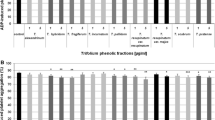Abstract
Organosulfur compounds in onion extracts are formed following thelysis of the S-alk(en)yl-L-cysteine sulfoxides by alliinase. Thesecompounds inhibit the aggregation of human blood platelets and offer thepotential for positive cardiovascular health benefits. An experiment wasdesigned to examine temporal and temperature effects on onion-inducedantiplatelet activity. Platelet aggregation is induced by various agonists,including ADP, collagen, and thrombin. Unexpectedly, all freshly-juicedonion extracts (ca. 5 minutes post-juicing) appeared to exhibit both anagonist-free aggregation peak (AFP) and a platelet inhibitory peak (PIP)characteristic of inhibition of platelet aggregation. The AFP was minimalby 30 minutes and dissipated in all treatments by 120 minutes, whilethe PIP increased as onion extracts aged and did not change after 30minutes at 25 °C. This finding confirms the observation that the in vitro platelet inhibitory activity of onion organosulfur compounds istime dependent. Freshly-prepared onion extracts were incubated with theADP scavenger enzyme apyrase (E.C. 3.6.1.5). AFPs were abolished inapyrase-treated extracts, suggesting that this response may have been dueto free ADP in onion extracts, although an amount of ADP required togenerate such a response would be unexpected in onion extracts. Inaddition, platelet aggregates were not observed in the AFP, suggesting thisresponse may be associated with changes in light transmission throughplatelet rich plasma that are not associated with platelet aggregation.Artifacts of analysis are, therefore, possible when assessing onion-inducedantiplatelet activity with freshly-juiced extracts. Temporal formation ofplatelet-inhibiting organosulfur compounds should be taken into accountduring both in vitro and in vivo assessment of onion-inducedantiplatelet activity.
Similar content being viewed by others
References
Anonymous (1995) American Heart Association, Heart and Stroke Facts. More information can be obtained at http://www.americanheart.org.
Anonymous (1988) Antiplatelet trialists' collaboration. Secondary prevention of vascular disease by prolonged antiplatelet treatment. British Med J 296: 320-331.
Gupta NM, Mehrstra RML, Sincar AR (1966) Effect of onion on serum cholesterol, blood coagulaiton factors and bibrinolytic activity in alimentary lipaemia. Indian J Med Res 54: 1.
Makheja AN, Vanderhoek JY, Bryant RW, Bailey JM (1980) Altered arachidonic acid metabolism in platelets inhibited by onion or garlic extracts. In Samuellson B, Paoletti R (eds), Advances in Prostaglandin and Thrombosis Research. New York: Raven Press, 6, pp. 309-312.
Morimitsu Y, Kawakishi S (1990) Inhibitors of platelet aggregation from onion. Phytochem 29: 3435-3439.
Lawson LD, Ransom DK, Hughes BG (1992) Inhibition of whole blood plateletaggregation by compounds in garlic clove extracts and commercial garlic products. Thrombosis Res 65: 141-156.
Goldman IL, Schwartz BS, Kopelberg M (1995) Variability if blood platelet inhibitory activity of Allium (Alliaceae) species accessions. Amer J Bot 82: 827-832.
Block E (1992) The organosulfur chemistry of the genus Allium-implications for the organic chemistry of sulfur. Agnew Chem Int Ed Engl 31: 1135-1178.
Morimitsu Y, Morioka YY, Kawakishi S (1992) Inhibitors of platelet aggregation generated from mixtures of Allium species and/or s-alk(en)nyl-L-cysteine sulfoxides. J Ag Food Chem 40: 368-372.
Goldman IL, Kopelberg M, Debaene JEP, Schwartz BS (1996) Antiplatelet activity in onion (Allium cepa) is sulfur dependent. Thromb Haem 76: 450-452.
Born GVR, Cross MJ (1963) The aggregation of blood platelets. J Phys 169: 178-195.
Mascelli MA, Worley S, Veriabo NJ, Lance ET, Mack S, Schaible T, Weisman HF, Jordan RE (1997) Rapid assessment of platelet function with a modified whole-blood aggregometer in percutaneous transluminal coronary angioplasty patients reveiving anti-GP IIb/IIIa therapy. Circulation 96: 3860-3866.
Thomas DJ, Parkin KL (1994) Quantification of alk(en)yl L-cysteine sulfoxides and related amino acids in Alliums by high-performance liquid chromatography. J Ag Food Chem 42: 1632-1638.
Randle WM, Bussard ML (1993) Streamlining onion pungency analysis. HortSci 28: 60.
Yoshida S, Matsuura C, Etani S (1989) Impairment of tonoplast H+-ATPase as an initial physiological response of cells to chilling in mung bean (Vigna radiata [L.] Wilczek). Plant Physiol 89: 634-632.
. Ball WJ, Atkinson, DE (1975) Adenylate energy charge in Saccharomyces cerevisiae during starvation. J Bacteriol 121: 975-980.
Russell-Smith NC, Flower RJ, Cardinal DC (1981) Measuring platelet and leukocyte aggregation/adhesion responses in very small volumes of whole blood. J Pharmacol Meth 6: 315-333.
Author information
Authors and Affiliations
Rights and permissions
About this article
Cite this article
Osmont, K.S., Arnt, C.R. & Goldman, I.L. Temporal aspects of onion-induced antiplatelet activity. Plant Foods Hum Nutr 58, 27–40 (2003). https://doi.org/10.1023/A:1024062330700
Issue Date:
DOI: https://doi.org/10.1023/A:1024062330700



